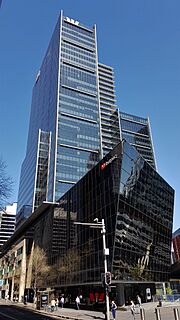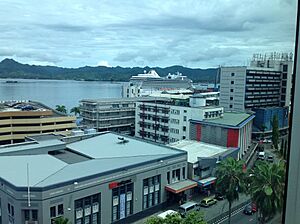Westpac facts for kids

Headquarters at Westpac Place in Sydney
|
|
| Public | |
| Traded as |
|
| Industry | Financial services |
| Predecessor | Bank of New South Wales Commercial Bank of Australia |
| Founded | 8 April 1817 (as the Bank of New South Wales) 4 May 1982 (as Westpac Banking Corporation) |
| Headquarters | Westpac Place Sydney, Australia |
|
Number of locations
|
626 |
|
Area served
|
Worldwide |
|
Key people
|
John McFarlane (chairman) Anthony Miller (CEO) |
| Products |
|
|
Operating income
|
|
| Total assets | |
| Total equity | |
|
Number of employees
|
35,240 (2024) |
| Subsidiaries | BankSA, Bank of Melbourne, St.George Bank, RAMS, Westpac New Zealand |
Westpac Banking Corporation, often called Westpac, is a large Australian bank. It offers many financial services around the world. Its main office is in Sydney, Australia, at Westpac Place.
Westpac started way back in 1817 as the Bank of New South Wales. This makes it Australia's first and oldest bank. In 1982, it merged with the Commercial Bank of Australia. After this, it changed its name to Westpac Banking Corporation. The name "Westpac" combines "Western" and "Pacific." Westpac is one of Australia's four biggest banks.
In 2024, Westpac served about 13 million customers globally. It also employed around 35,000 people. In 2022, it was ranked among the top 1000 banks worldwide.
Contents
Westpac's Journey Through Time
Westpac Banking Corporation was created in 1982. This happened when the Bank of New South Wales joined with the Commercial Bank of Australia. The new name, Westpac, showed its goal to be a major bank in the Western Pacific Ocean region. The "W" from the old Bank of New South Wales logo was kept.
Here are some important moments in Westpac's history:
- 1984: Westpac and the government of Kiribati started a new bank together. This bank also acted like Kiribati's central bank.
- 1985: Westpac began working with the National Bank of Tuvalu. It bought 40% of the shares.
- 1988: Westpac grew by buying other banks in places like the Cook Islands and the Solomon Islands. It also opened the only bank in Niue.
- 1990: Westpac bought parts of banks in Tonga, New Caledonia, and Tahiti.
- 1992: Westpac faced a big challenge. It had a large loss of money. This made it go from Australia's biggest bank to the third largest.
- 1995: Westpac sold its shares in the National Bank of Tuvalu back to the government. It also bought Challenge Bank.
- 1996: Westpac bought Trust Bank in New Zealand. This made it the largest bank there.
- 1997: Westpac bought Bank of Melbourne in Victoria, Australia.
- 2001: Westpac changed its ownership in banks in Kiribati, Samoa, and Tonga.
- 2002: Westpac added BT and Rothschild Australia Asset Management to its group.
- 2004: Westpac sold its branch in Niue to the Bank of South Pacific.
- 2008: Gail Kelly became the chief executive officer. Westpac also announced plans to merge with St George Bank. This merger was approved later that year.
- 2011: Some St George branches in Victoria became Bank of Melbourne branches again.
- 2012: Westpac made some changes to its staff.
- 2014: Brian Hartzer became the new CEO.
- 2017: Westpac celebrated its 200th birthday!
- 2020: Peter King was appointed CEO.
- 2024: Anthony Miller became the CEO of Westpac.
Between 2015 and 2025, Westpac closed over 400 branches in Australia. This included many Bank of Melbourne branches. Some branches were combined, meaning Westpac and a smaller bank like BankSA shared one location.
Who Leads Westpac?
Westpac has important leaders who guide the company.
Chief Executive Officers
The Chief Executive Officer (CEO) is in charge of running the bank every day.
| # | Name | Term start | Term end |
|---|---|---|---|
| 1 | Bob White | 4 May 1982 | 31 December 1987 |
| 2 | Frank Conroy | 1 January 1988 | December 1992 |
| 3 | Robert L. Joss | 15 February 1993 | February 1999 |
| 4 | David Morgan | 1 March 1999 | 31 January 2008 |
| 5 | Gail Kelly | 1 February 2008 | 1 February 2015 |
| 6 | Brian Hartzer | 1 February 2015 | 2 December 2019 |
| 7 | Peter King | 2 December 2019 | 16 December 2024 |
| 8 | Anthony Miller | 16 December 2024 | Incumbent |
Chairs of the Board
The Chairman leads the board of directors, which oversees the company.
| # | Name | Term start | Term end |
|---|---|---|---|
| 1 | Sir Noel Foley | 4 May 1982 | 30 January 1988 |
| 2 | Sir James Foots | 30 January 1988 | January 1989 |
| 3 | Sir Eric Neal | January 1989 | October 1992 |
| 4 | John Uhrig | October 1992 | December 2000 |
| 5 | Leon Davis | December 2000 | March 2007 |
| 6 | Ted Evans | March 2007 | 14 December 2011 |
| 7 | Lindsay Maxsted | 14 December 2011 | 2 April 2020 |
| 8 | John McFarlane | 2 April 2020 | Incumbent |
How Westpac Works
Westpac has five main parts that help it serve its many customers. These parts include: Consumer Bank, Commercial and Business Bank, BT Financial Group, Westpac Institutional Bank, and Westpac New Zealand.
Consumer Bank
This part of Westpac helps regular people with their daily banking. It serves about 9 million customers in Australia. It offers services like bank accounts and loans. This is done through branches, ATMs, and online banking. It includes brands like Westpac, St George, BankSA, Bank of Melbourne, and RAMS.
Business Bank
The Business Bank helps small to medium-sized businesses. It also works with larger companies and farms in Australia. They offer services like loans for businesses and advice on managing money. This part of the bank also uses the Westpac, St George, BankSA, and Bank of Melbourne brands.
BT Financial Group
BT is Westpac's brand for managing wealth. This means they help people with investments and superannuation (retirement savings). They also offer different types of insurance.
Westpac Institutional Bank
This part of Westpac works with very large companies, governments, and other big organizations. They offer special financial services. These services include managing large transactions and helping with investments. They have offices in Australia, New Zealand, the US, the UK, and Asia.
Westpac in New Zealand

Westpac opened its first branches in New Zealand in 1861. Today, Westpac New Zealand offers full banking services. It has about 1.5 million customers and 196 branches. It is one of the four biggest banks in New Zealand. It also handles banking for the New Zealand government.
ATM Alliance
Westpac is part of the Global ATM Alliance. This is a group of big international banks. It lets customers use their bank cards at ATMs of other banks in the alliance without extra fees when traveling. Other banks in this group include Bank of America and Deutsche Bank.
Westpac for Migrants
This service helps people moving to Australia or New Zealand. They can open bank accounts before they even arrive. They can also get credit cards or home loans approved early. Westpac has offices to help with this, including one in London.
Westpac in the Pacific

Westpac also operates in seven countries in the South Pacific. Its main office for this region is in Sydney. They offer online banking, ATMs, and accounts for personal and business customers. Westpac Fiji is a large bank in Fiji, holding a 40% share of the market.
Westpac Outstanding Women Awards
Westpac celebrates professional women in Papua New Guinea each year. They give out the Westpac Outstanding Women Awards. These awards recognize women doing great work in different areas.
Banking Alliance for Women
Westpac Pacific Banking is part of the Global Banking Alliance for Women. This group supports projects in the Pacific region. These projects help women succeed and grow their businesses.
Reinventure
Westpac has invested in a group called Reinventure. This group invests in new technology companies. Their goal is to improve how technology is used in financial services. Reinventure has invested in companies like BrickX and OpenAgent.
Being a Responsible Company
Westpac cares about being a responsible company. In 2002, they shared a report about their plans. This report showed how they aimed to meet international standards for being a good corporate citizen. Because of this, Westpac was recognized as a top bank for sustainability from 2004 to 2007.
Westpac has faced some criticism. Some groups have raised concerns about its support for certain logging operations.
Westpac was one of many large Australian companies that supported the 'Yes' campaign for the 2023 Australian Indigenous Voice referendum.
See also
 In Spanish: Westpac para niños
In Spanish: Westpac para niños
- Banking in Australia
- Global ATM Alliance
- List of banks in Australia
- List of banks in Oceania
- Westpac House
- Westpac Life Saver Rescue Helicopter Service
- Westpac Rescue Helicopter (New Zealand)
- Westpac Stadium
- List of Westpac buildings

